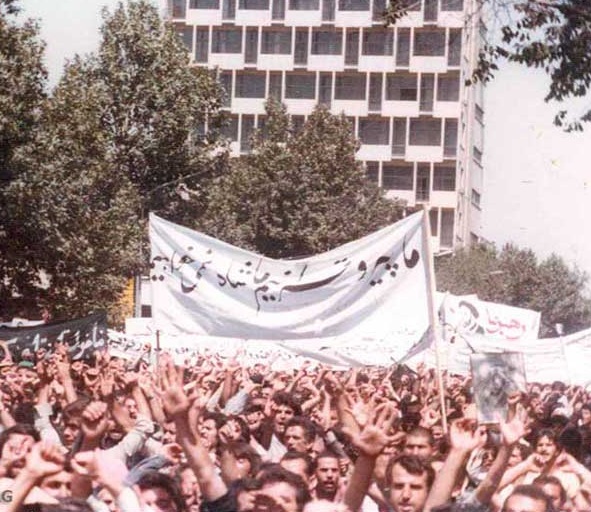The Iranian Revolution led to the overthrow of Mohammad Reza Shah Pahlavi, the latest ruler in the Persian monarchy that had been ruling for 2,500 years. The Grand Ayatollah Ruhollah Khomeini led this revolution, and he eventually ran the Islamic republic that replaced the monarchy after overthrowing the shah.1 The Iranian Revolution transformed Iran’s government and the lives of all its citizens by making religion a key factor in all new laws that they made, as a reaction to the westernizing policies of the shah.
Mohammad Reza Shah Pahlavi was the shah of Iran from 1941 to 1979. He fostered economic development in Iran and also maintained a pro-Western foreign policy. Mohammad Reza’s father, Reza Shah Pahlavi, was an army officer who founded the Pahlavi dynasty in 1925 as he became the ruler of Iran. In 1941 the Soviet Union and Great Britain invaded Iran, forcing Reza Shah into exile, leading to his son Mohammad Reza replacing him in this position. During his time as shah, Mohammad Reza carried out a national development program called the White Revolution with the help of the United States. This White Revolution included many new developments, such as land reform, an expanded road, rail, and air network, and the eradication of diseases such as malaria. This revolution helped the shah gain signifiant domestic support, but he also received political criticism from people who believed the reforms were not doing enough or were not working fast enough to modernize Iran. Along with political criticism, he also received religious criticism from people who thought westernization contradicted Islam.2 This is what would later lead to the shah’s overthrow by Ruhollah Khomeini and his followers.

When Reza Shah came into control in 1925, the status of women changed significantly because he introduced policies that brought change to their lives. He wanted to create a state modeled after Westernism and Europeanism. Because he wanted the Iranian state to be a society with secular ideas and a modern outlook, his policies worked to liberate women. He enacted a Family Protection Act that established family courts to handle divorce and child custody cases. This gave women the right to “divorce on the same grounds as men, and both had to go in court for divorce. For marriage, the minimum age for women was raised from 15 to 18.” In addition to this the shah also “legalized abortion and created family planning and day care centers for women who wanted to work.”3 This act specifically was what angered religious citizens because it went against what they believed in. The implementation of these new policies sparked the beginnings of the well-known Iranian Revolution.

Ruhollah Khomeini, the leader of the Iranian Revolution, was the grandson and son of Shiite religious leaders. He followed in his family’s path to become a Shiite scholar and teacher. He produced a number of writings in Islamic philosophy, law, and ethics, but what made him best known among the people of Iran was his opposition to Mohammad Reza Shah Pahlavi and everything he was doing. In the 1950s he was given the title of an ayatollah, which is a major religious leader among Shiites. By the 1960s, he received the title of grand ayatollah, which made him one of the supreme religious leaders of the Shiite community of Iran. His eventual arrest sparked antigovernment riots, specifically against what the shah was implementing. He stood as the voice for the Shiite community and spoke up about how the shah’s policies contradicted what the Shiite community believed in. In 1964, he was exiled from Iran. He settled in a holy city in Iraq where he continued to speak out against the shah and call for his overthrow and the establishment of an Islamic republic. His influence grew drastically from the mid-1970s. In 1978 he was forced to leave Iraq by the country’s ruler, Saddam Hussein. Khomeini settled in a suburb of Paris where his supporters relayed tape-recorded messages of him speaking to his supporters in Iran, resulting in enormous demonstrations, strikes, and riots.4 These riots would lead to what is today known as the Iranian Revolution and the overthrow of Mohammad Reza Shah Pahlavi and the Persian Monarchy.
In January of 1979, the shah and his family fled Iran on what was officially described as a “vacation”.5 Shortly after this Khomeini returned and took control of the country as the religious leader of the revolution.6 On April 1, he officially declared Iran an Islamic republic.7 The shah and everyone in his regime, met the same fate his father did all those years ago, as they were officially sent into exile. They will never be able to return to the country as long as it remains an Islamic republic. People in the shah’s regime left their families to escape while they still had a chance to leave. Some left easily with their families on “vacations,” but others had to leave on foot through mountains hoping to survive the journey to safety, praying to be reunited with their families one day. Those who did not make it out on time or refused to leave knew they would be arrested or even killed. Many of the people in the regime struggled to find asylum and some even had to move to a few different countries before finally settling. Mohammad Reza Shah Pahlavi also traveled to several different countries before finally receiving asylum in Cairo, Egypt where he passed away in 1980 due to cancer.8
With this new Islamic republic, many new laws were implemented by Khomeini. These laws included requiring women to wear a veil, the banning of alcohol, and the banning of Western music.9 In addition to this, The Family Protection Act was voided.10 The rights that women had gained during the shah’s reign were taken away from them, and things had become even more strict. One law lowered the age of marriage for girls to eight years old, and another gave fathers the right of child custody in the case of a divorce. There was even gender segregation on public transportation on which there were fewer seats even available for women. During the shah’s reign there had been an increase of women in labor force participation, but following these new religious laws, there was a drastic decrease of women in the workforce. Some women of high-ranking positions were even forced to step down because of these new laws.11 Rights of women have improved slightly since then but they still are not like what they used to be. Everything that the shah had worked to change, westernization and liberation of women specifically, had been overturned by the new Islamic Republic.

Recently at the beginning of 2018, demonstrations arose which were organized by the royalists to overthrow the dictatorship in Iran and adopt a new monarchy that supports Westernization. The late shah’s oldest son, Reza Pahlavi, the crown prince of Iran, has expressed his support for these new protests. In an interview the crown prince had accused the Iranian government of being resistant to change, he stated, “Iran needs an overall change. All Iranians want change, it is time for change. The Green Movement in 2009 was a clear reflection that the people of Iran were, and still are, quite unhappy with the Islamic regime and its constitution.”12 He hopes this could possibly lead to him and many others finally being able to return back to their home country. Reza Pahlavi currently lives with his wife and three daughters in Washington, D.C.
The Iranian Revolution changed Iran in many ways, especially in the day-to-day lives of its citizens. Although the lives of men were also affected, the lives of women changed most drastically due to many laws taking their rights away. In addition, the lives of all those who were a part of the shah’s regime and of their families were also transformed. They were forced out of their homes and had to move to new countries and restart their lives. Many of these people are not able to return to Iran still, and some of them may never get the opportunity to go back. With how things are in the country right now, there may be another revolution arising. People are tired of the way things are in the country and want less religion and more modernization. Will this revolution take things back to the way they were during the monarchy? Will the Islamic republic be overthrown? Will women finally be liberated again? Will the royal family finally be able to return to their home? As of now, none of these questions have answers, only time will tell what is in store for Iran’s future.
- Wikipedia, 2018, s.v. “Iranian Revolution.” ↵
- Encyclopaedia Britannica, July 2018, s.v. “Mohammad Reza Shah Pahlavi.” ↵
- Sadia Rafique and Khalid Manzoor Butt, “Position of Women in Iran: An Analysis of Pre and Post Islamic Revolution 1979,” South Asian Studies 32 (2017): 431-439. ↵
- Encyclopaedia Britannica, September 2018, s.v. “Ruhollah Khomeini.” ↵
- Encyclopaedia Britannica, April 2018, s.v. “Iranian Revolution of 1978-79,” by Janet Afary. ↵
- Encyclopaedia Britannica, September 2018, s.v. “Ruhollah Khomeini.” ↵
- Encyclopaedia Britannica, July 2018, s.v. “Mohammad Reza Shah Pahlavi.” ↵
- Encyclopaedia Britannica, July 2018, s.v. “Mohammad Reza Shah Pahlavi.” ↵
- Encyclopaedia Britannica, September 2018, s.v. “Ruhollah Khomeini.” ↵
- Encyclopaedia Britannica, April 2018, s.v. “Iranian Revolution of 1978-79,” by Janet Afary. ↵
- Sadia Rafique and Khalid Manzoor Butt, “Position of Women in Iran: An Analysis of Pre and Post Islamic Revolution 1979,” South Asian Studies 32 (2017): 431-439. ↵
- Aanmoen, Oskar. “Crown Prince Reza Pahlavi Issues New Statement to Iranian Royalists Following Demonstrations.” Royal Central, 23 Apr. 2018, royalcentral.co.uk/international/crown-prince-reza-pahlavi-issues-new-statement-to-iranian-royalists-following-demonstrations-101028. ↵



28 comments
Makenzie Santana
I can’t even imagine what is must be like to move backwards instead of forward, to have rights taken away, to be forced to step down all because of their aspects of religion. The country that has a never ending war was starting to improve their government and do the right thing and a new leader came in and brought a huge setback. It’s devastating to know that those who were trying to improve the country under Shah’s movement were forced to leave without the hope of ever coming back.
Krystal Rodriguez
Its very interesting seeing how different our nations government is to a place like iran. Their monarchy seems to be getting better for them and although they can be resistant to change, its good that they are starting to give it a better approach. Their religious ties with government differ from ours. I truly hope they take a more democratic approach as their government changes and that it changed even more for the better.
Thomas Fraire
Perusing however this story, one idea occured in my mind, for what reason didn’t anybody see how dams functioned when they fabricated it and when others got it. I don’t know quite a bit of how dams function however this article truly gave great knowledge of how they ought to be worked. I enjoyed how it would tell the peruser the blunder that had been committed and why it was an error on the proprietors part. The associations made between data given was extremely elegantly composed, for example how the creator referenced Andrew Carnegie, and his notoriety in the Gilded Age, at that point associated it to Ruff, who was the proprietor of the dam. It didn’t influence it to appear squandered data. It was additionally extremely contacting what number of nations connected and helped the individuals who were influenced, which I thought didn’t occur all the time in that timeframe.
Isaiah Torres
It’s mind blowing how different a nation can be with the effect of religion. When you compare places like Iran to America tied in with religion, the differences are astonishing. I do not believe that monarchy is a right thing to have for a nation, but in some of the examples above, it shows some of the changes made related to abortion and to the legal age of marriage. The most interesting part to me was when the new polices were discussed and the effect that it had on many people as well as the leadership of the nation.
Mariah Garcia
It is interesting to read the history of Iran especially the religion that changed the nation. I find it quite sad that Shah had implemented so many policies that gave women rights and opportunities. But, because of a man, Ruhollah Khomeini, who didn’t want change overthrew Shah and made the religious laws stricter for women. I couldn’t believe that women who had a high position in their job had to step down because of the new policies. Shah wanted to change Iran for the betterment of the people, especially the women, but because of a religion and one man Iran stayed stagnant with stricter laws.
Oscar Ortega
This explanatory article is impressive. For many Americans, the history, especially recent political history of ‘Middle Eastern’ countries is something of a mystery. We know that places like Iraq and Iran are Islamic states where ‘they hate the west’ and ‘women don’t have rights thanks to religion’, but looking even just a bit deeper at the actual reasons and history behind the countries, we see just how little we actually know. I personally never knew anything about the Iranian revolution or Muhammad Raza Shah before reading this Article, and learning about the Persian monarchy and what it tried to do and why it failed have not only taught me much about the divisions all countries face when it comes to religious ideals, but have piqued my interest enough to motivate me to look at current events in countries like Iran.
Alicia Guzman
This article is very interesting because this provides the perspectives and the background from both sides of the political revolution in Iran in the 1970s. As someone who has grown up in Western culture, it is very easy to sympathize with the Iranian Royal family. I would be very interested to see where the Royal Family is today. It is so sad that women have lost so many rights. I would love to see a comprehensive article detailing a timeline of the political history of Iran since the Revolution.
Christopher Hohman
Nice article. It is always very interesting to see two conflicting world views play out in a nation’s history. I believe that it is unfortunate that the people of Iran, especially the women, have had their rights taken away from them. It must be hard to have those rights one day and then for them to be gone the next. As for the Iranian royal family I feel bad for them a little. It must have been hard for them to leave their country and have no realistic prospect of return.